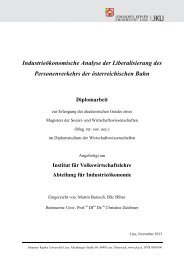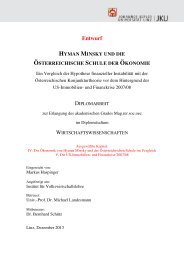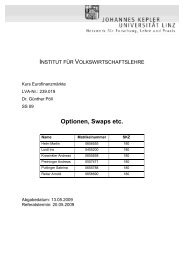Presentation
Presentation
Presentation
You also want an ePaper? Increase the reach of your titles
YUMPU automatically turns print PDFs into web optimized ePapers that Google loves.
Ursachen und Prognosemöglichkeiten<br />
Autor:<br />
Clemens Hubmer<br />
Betreuer: Prof. Dr. Michael Landesmann<br />
Dr. Bernhard Schütz
Debtcrisis<br />
• cause high costs for the national economy<br />
• In most cases it occur unxpectedly<br />
• Financial crises are generally difficult to predict—<br />
witness the poor performance of international interest<br />
rate spreads and currency forecasts<br />
1 Vgl.:Reinhart, C. M. (2002). Default, currency crises, and sovereign credit ratings. The World Bank Economic Review, 16(2), 151-170.
Which type of debt exist<br />
• External debts:<br />
• Issued in foreign law and currency2<br />
• Repayment requires foreign currency<br />
• Domestic debts:<br />
• Issued in local law and currency3<br />
• Could be devalued through inflation<br />
2-3 Vgl:Reinhart C., Rogoff K. (2009): This time is different, Princeton University Press, Princeton and Oxford, Seite 10-13
Which type of crisis exist<br />
• Illiquiditity 5<br />
• Short-term funding problem<br />
• Insolvency 6<br />
• reschedule of the repayment terms less favorable for the<br />
creditor<br />
• based on a comparison of cost<br />
5Vgl.: Reinhart C., Rogoff K. (2009): This time is different, Princeton University Press, Princeton and Oxford, Seite 59-60<br />
6Vgl.: Reinhart C., Rogoff K. (2009): This time is different, Princeton University Press, Princeton and Oxford, Seite 10-13
When do crisis occur<br />
• Illiquidity<br />
• Illiquidity hardly ever occur, because they can be solve<br />
from other countries or international institutions like<br />
the IMF by providing a bridging loan 6<br />
• Insolvency<br />
• They occur rarley but in waves7<br />
• In cases where no bridging loans are provide this dues to<br />
the unwillingness of countries to accept the conditions.<br />
6 Vgl.: Reinhart C., Rogoff K. (2009): This time is different, Princeton University Press, Princeton and Oxford, Seite 10-13<br />
7 Vgl.: Reinhart C., Rogoff K. (2009): This time is different, Princeton University Press, Princeton and Oxford, Seite 10-13
Sample<br />
• OECD – Countries 1980 -2012<br />
• There are only a few dept crisis in OECD countries<br />
observable (Turkey, Chile und Mexico)<br />
• The actual definition provide not enough observations
Extantion of the definition<br />
• Consideration ofdifficulties connected with debts<br />
• Inability to issue long-term debts<br />
• High interest charges
Extantion of the definition<br />
• High real interest rates<br />
• Deteriation in refinancing condition<br />
• High values in realinterest rate compared to country<br />
specific average growth rate<br />
• Indeptness growth by itself<br />
• Interest rate levels weeighted with the rate of indeptness<br />
• The weighting brings the refinancing conditions in relation to<br />
the refinancing requirements
Schätzer<br />
• Extanded defintion<br />
• 5year average of the explainig variables (without crisis)<br />
• Interestrate as a function of the variables<br />
• i=ß1+ß2*g+ß3*NX+ß4*NX^2+ß5*Inflation+ß5*inflation^2<br />
+ß6*GDPperhead+ß8*GDPperhead^2<br />
+ß8GDP+ß9GDP^2+ß10*reference rate+ ß11* indebtedness<br />
+ß12* indebtedness ^2+ß13*exchangerate+ß14*public<br />
deficit+ß15*Crisis+ß16*Crisis^2
Schätzer<br />
• Extanded definition<br />
• Defind benchmarks<br />
• probability as a function of<br />
the variables<br />
• Logit Regression
Stability of public finances<br />
• Rate of indebtness<br />
• Public deficit
Economic variables<br />
• Exchangerate system<br />
• Balance of payment<br />
• Real GDP growth<br />
• Inflation<br />
• GDP per Head<br />
• GDP<br />
• Referenc rate
Crisis<br />
• Default history<br />
• Number of crisis in the oecd countries
Current database<br />
• OECD-statistics<br />
• Reinhardt/Rogoff<br />
• ECB
Current literature<br />
• Hayek Friedrich A. (1976): Geldtheorie und Konjunkturtheorie, 2. erw.<br />
Auflage, Wolfgang Neugebauer Salzburg<br />
• Schumpeter Josef A. (1961): Konjunkturzyklen l Eine theoretische,<br />
historische und statistische Analyse des kapitalistischen Prozesses,<br />
Vandenhoeck & Ruprecht in Göttingen,<br />
• Keynes John M., (1936)Allgemeine Theorie der Beschäftigung, des<br />
Zinses und des Geldes<br />
• Lucas Robert E., Theorie der Konjunkturzyklen<br />
• Rogoff Kenneth S., Reinhart Carmen M., (2009) This Time is different;<br />
Eight Centauries of financial folly, Princeton Press
Current literature<br />
• Gustav Ranis, (2004) HUMAN DEVELOPMENT AND ECONOMIC GROWTH,<br />
ECONOMIC GROWTH CENTERYALE UNIVERSITY<br />
• Paul R. Krugman, Maurice Obstfeld, (2009)Internationale Wirtschaft, Theorie<br />
und Politik der Außenwirtschaft 8. Auflage,<br />
• Theurl, E., Winner, H., & Sausgruber, R. (Eds.). (2002). Kompendium der<br />
österreichischen Finanzpolitik. Springer DE.<br />
• Amtsblatt der Europäischen Union, (2013)Rechtsvorschriften, 56. Jahrgang 27.<br />
Juni<br />
• Rainer Schweickert, März 1992 Peter Nunnenkamp und Ulrich Hiemenz<br />
Stabilisierung durch feste Wechselkurse: Fehlschlag in Entwicklungsländern<br />
— Erfolgsrezept für Osteuropa? Kieler Diskussionsbeiträge,
Current literature<br />
• Flassbeck, Heiner. "Geldpolitik und Beschäftigung." Empirische Forschung und<br />
wirtschaftspolitische Beratung, Festschrift für Hans-Jürgen Krupp zum 65 (1998): 275-289<br />
• Baumstark, E. (1833). Staatswissenschaftlichen versuche über staatskredit, staatsschulden<br />
und staatspapiere: nebst drei anhaengen, enhaltend zwei uebersichten der englischen und<br />
französischen finanzen seit dem eilften jahrhunderte und eine zusammenstellung aller im<br />
europäischen handel vorkommenden staatspapiere. G. Reichard.<br />
• Amtsblatt der Europäischen Union, (2013)Rechtsvorschriften, 56. Jahrgang 27. Juni<br />
• Rainer Schweickert, März 1992 Peter Nunnenkamp und Ulrich Hiemenz Stabilisierung<br />
durch feste Wechselkurse: Fehlschlag in Entwicklungsländern — Erfolgsrezept für<br />
Osteuropa? Kieler Diskussionsbeiträge,<br />
• Helmedag, Fritz. (2010): Staatsschulden als permanente Einnahmequelle,<br />
Wirtschaftsdienst 90.9
Current literature<br />
• Vesper, Dieter. (2007)."Staatsverschuldung und öffentliche Investitionen." IMK<br />
Policy Brief November<br />
• Ehrig, D., & Staroske, U. Japans Beschäftigungspolitik und die Weltfinanzen:<br />
Mit Keynes aus der Krise? Preliminary Draft!!.<br />
• Schnabl, G. (2005). Der Festkurs als merkantilistische Handelspolitik: Chinas<br />
Währungs-und Geldpolitik im Umfeld globaler Ungleichgewichte (No. 291).<br />
Tübinger Diskussionsbeiträge.<br />
• Pusch, T. (2007). Verteilungskampf und geldpolitische Sanktion.<br />
• Borner, S. (1971). Das Beschäftigungs-Inflationsdilemma: Eine theoretische<br />
Analyse der wirtschaftspolitischen Relevanz der Phillips-Kurve. Swiss Journal<br />
of Economics and Statistics (SJES,
Current literature<br />
• Tomann, Horst. (1997) Stabilittspolitik/Stability Policy: Theorie, Strategie Und Europische<br />
Perspektive. Springer DE,<br />
• International Monetary Fund (2013) World economic outlook 2013<br />
• Sinn, H. W. (2002): Die rote Laterne. ifo Inst. für Wirtschaftsforschung,<br />
• Neu, A. D. (1995): Subventionen ohne Ende? Steinkohlenbergbau und Energieverbrauch in<br />
Deutschland (No. 248), Kieler Diskussionsbeiträge,<br />
• Mag. Karin Steigenberger (2012) Wohlstand braucht Wachstum, Stabsabteilung<br />
Wirtschaftpolitik Wirtschaftskammer Österreich,<br />
• Grunert, G.(2009): Droht eine Horror-Inflation?.<br />
• Stockhammer, E., & Ramskogler, P. (2009). Wie weiter? Zur Zukunft des<br />
Postkeynesianismus. Wirtschaft und Gesellschaft-WuG, 35(3).
Thanks for your<br />
attention!






